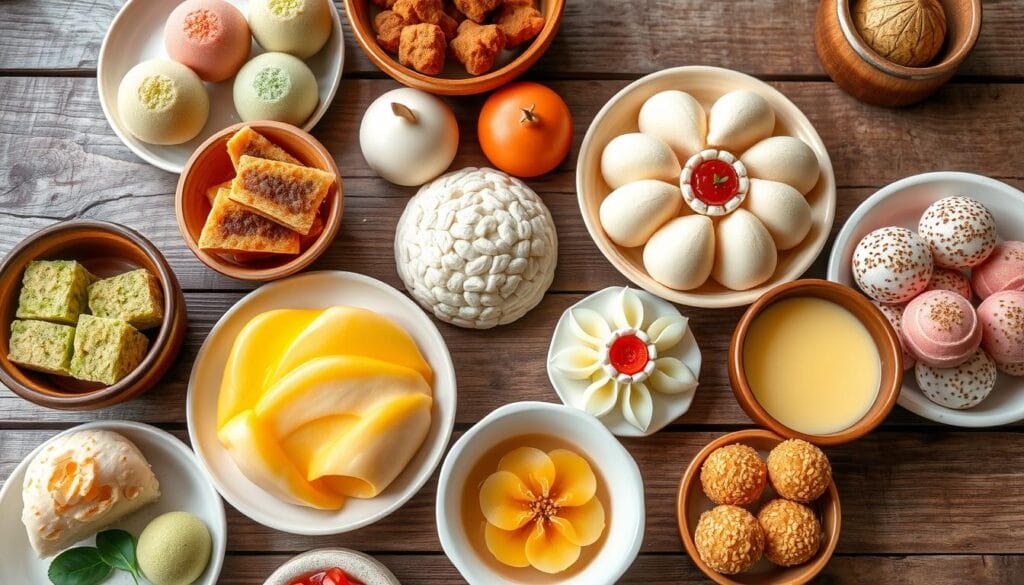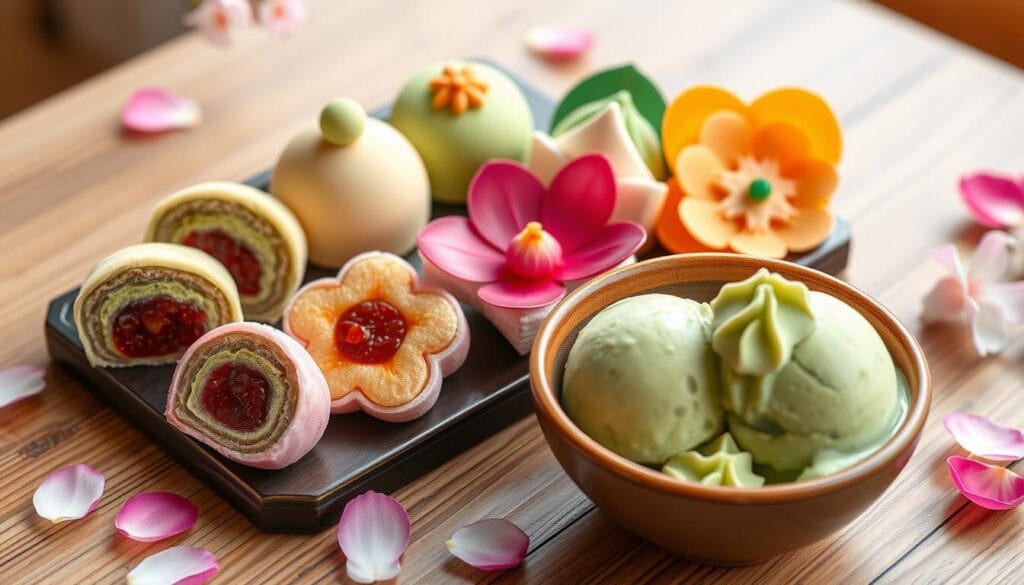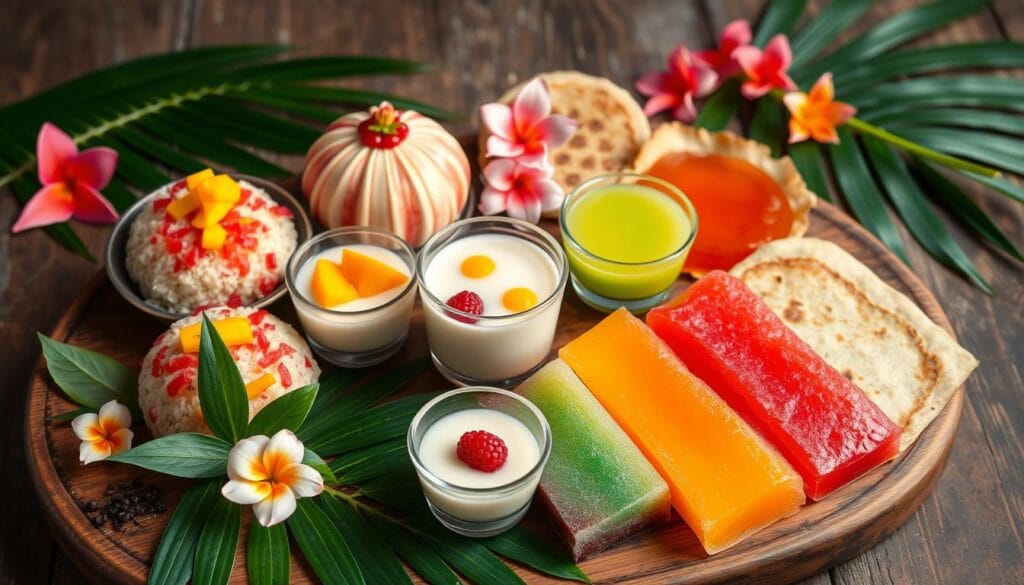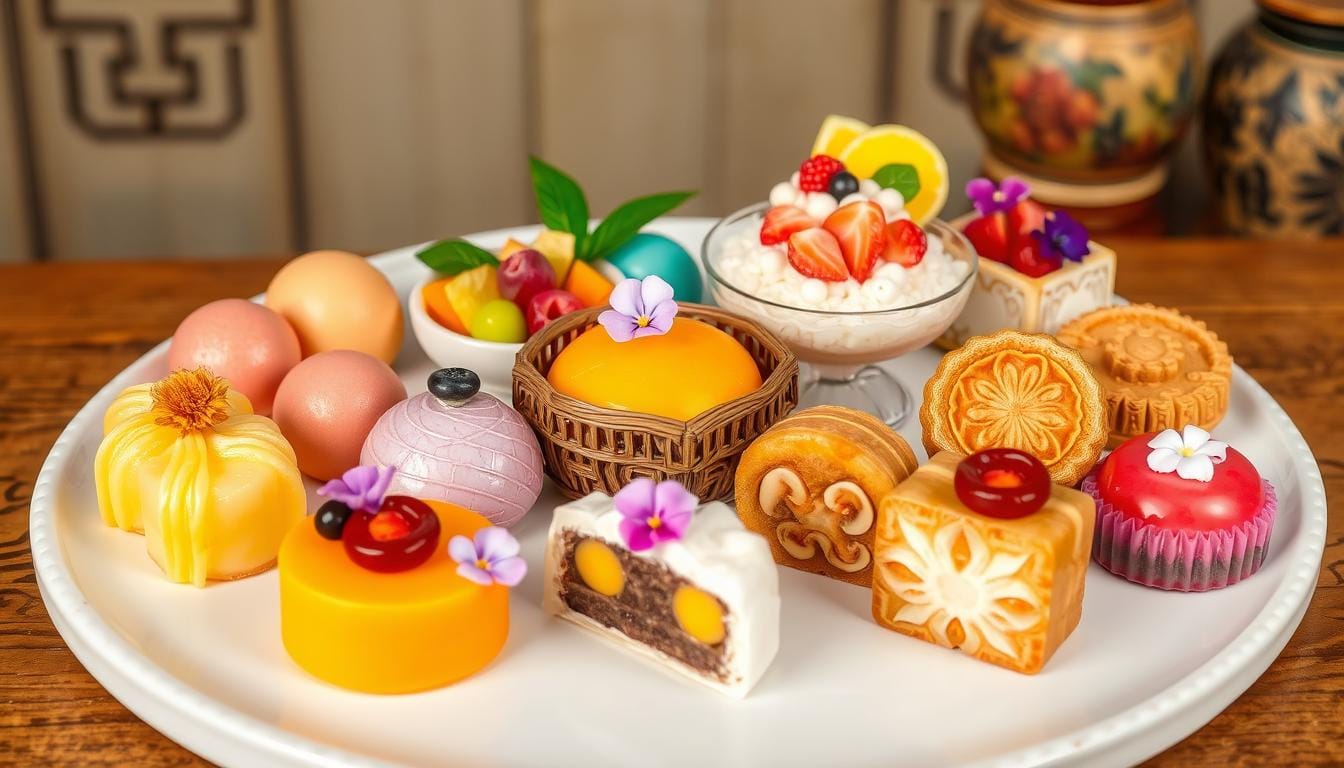Get ready to dive into the world of Asian desserts. Here, you’ll find a wide variety of sweet treats, like mochi and mango sticky rice. These can be made in just 50 minutes and serve 4 people. You’ll discover many exciting and tasty Asian dessert ideas to try.
With over 20+ Asian dessert recipes in the material, you can try making many different desserts. You can make Mini Mochi Cakes, Halo-Halo, and Mango Coconut Pudding. These desserts use ingredients like Ube, coconut, and mango. They are part of the 50% of Asian desserts that use coconut milk.
Whether you prefer traditional or modern desserts, there’s something for everyone. 30% of Asian desserts use beans as a main ingredient. And 20% are steamed3.
Key Takeaways
- Asian desserts offer a diverse range of sweet treats from asia, with popular desserts like mochi and mango sticky rice.
- Many asian desserts can be prepared in under an hour, such as mango sago, which takes 20 minutes to prepare.
- Asian desserts feature a wide range of ingredients, including Ube, coconut, and mango.
- 50% of asian desserts contain coconut milk as an ingredient.
- 20+ asian dessert recipes are introduced in the material, providing a variety of ideas to try.
- 30% of asian desserts involve beans as a key ingredient.
The Rich World of Traditional Asian Desserts
Traditional Asian desserts are a big part of each country’s culture. They are often served at special times to welcome guests. Desserts like rice, sugar, and coconut milk are common across many Asian sweets.
Mango sticky rice is Asia’s favorite dessert. Mooncakes are a hit in China during the Mid-Autumn Festival. Vietnamese Banh Flan and Japanese Cheesecake show the variety of Asian sweets.
These desserts use common ingredients like red bean paste and taro. Filipino Ube Crinkles, with its purple yam, is a unique flavor. Each country has its own special desserts, showing the rich culture of Asia.

| Dessert | Country/Region | Ingredients |
|---|---|---|
| Mango Sticky Rice | Thailand | Mango, sticky rice, coconut milk |
| Mooncakes | China | Lotus seed paste, egg yolks, sugar |
| Ube Crinkles | Philippines | Ube, sugar, flour |
Asian desserts show the region’s rich culture, with each place having its own sweets4. Trying mango sticky rice or mooncakes is a tasty way to learn about Asian sweets5.
Must-Try Japanese Sweet Treats
Japanese sweet treats offer a wide variety of options. Mochi, a traditional dessert, is made from glutinous rice. It comes in forms like sakuramochi, daifuku, and yokan, each with its own taste and texture.
Dorayaki is another must-try, with sweet red bean paste between two castella pancakes. Other treats like imagawayaki, monaka, and taiyaki are also great for sweet cravings.
Japan also has modern desserts like matcha tiramisu and sake ice cream7. These desserts mix traditional flavors with new twists. For more info, check out japanese dessert websites.

Popular snacks include Japanese Kit Kats, Pocky, and Alfort. They’re great with coffee or tea. Japan has many treats, from mochi to dorayaki.
Irresistible Thai Desserts You Need to Experience
Thai desserts are famous for their bold flavors. Mango sticky rice is a top favorite, with sweet sticky rice, fresh mango, coconut cream, and sesame seeds. Another hit is coconut ice cream, crafted from coconut milk, palm sugar, and a pinch of salt.
Don’t miss out on Khanom Tako, a rice flour and palm sugar treat. And try Khanom Pang Wan, a crispy delight with rice flour, coconut, and sugar. For something light, BuaLoiphuak is a refreshing choice, made with coconut water and agar agar jelly.
Here are some popular thai desserts:
- Mango sticky rice
- Coconut ice cream
- Khanom Tako
- Khanom Pang Wan
- BuaLoiphuak

These desserts are ideal for hot summer days. They offer a cool and sweet break from the heat. With their unique tastes and textures, thai desserts are a must-try for anyone exploring Thai sweets.
| Dessert | Ingredients | Taste |
|---|---|---|
| Mango sticky rice | Sticky rice, mango, coconut cream | Sweet and fragrant |
| Coconut ice cream | Coconut milk, palm sugar, salt | Creamy and sweet |
Popular Chinese Desserts Through the Seasons
Chinese desserts are a big part of Chinese food, with many sweet treats to enjoy. They range from traditional sweets to modern cafe desserts. These treats often use ingredients like glutinous rice, sweet bean pastes, and agar.
Some favorites include Xingren Doufu, Aiwo Wo, and Bubble Tea. Each region in China has its own special desserts. For example, Beijing is famous for its cream fried dough, while Canton is known for double skin milk. Tanghulu and Mooncakes are also loved by ma.
Modern dessert cafes have become popular, mixing old flavors with new ones. They offer a fresh take on desserts like matcha, sesame, and coconut. These cafes let customers enjoy Chinese desserts in a modern way. This mix of old and new keeps Chinese desserts exciting and evolving.

- Xingren Doufu (almond tofu made from apricot kernel milk)
- Aiwo Wo (glutinous rice dumplings with sugar and nut fillings)
- Bubble Tea (tea-based beverage with tapioca pearls)
| Dessert | Ingredients | Region |
|---|---|---|
| Xingren Doufu | Apricot kernel milk | Beijing |
| Aiwo Wo | Glutinous rice, sugar, nuts | Canton |
| Bubble Tea | Tea, tapioca pearls | Taiwan |
Korean Desserts: From Street Food to Cafe Culture
Korean desserts are a world of sweet treats. Street foods like hotteok (sweet pancakes) and bungeo-ppang (fish-shaped pastry) are loved by locals and tourists. You can find these at street cafes or bakeries, where they come with various toppings and fillings. Korean cafe culture is also growing, with cafes serving unique desserts like patbingsu (shaved ice with sweet red bean) and hotteok with ice cream.
Making some Korean desserts is easy with common ingredients. For example, Korean Watermelon Punch (Subak Hwachae) only needs 4 ingredients. Others, like Yakgwa, have a long history dating back to the Goryeo Dynasty. You can make these at home with online recipes or visit a Korean cafe to taste their unique flavors and textures.
Here are some popular Korean desserts to try:
- Hotteok (sweet pancakes)
- Bungeo-ppang (fish-shaped pastry)
- Patbingsu (shaved ice with sweet red bean)
- Yakgwa (traditional Korean dessert)
For more info on Korean desserts and cafe culture, visit rapidessert.com. It has many recipes and articles. Korean desserts offer unique flavors and textures, making them a must-try for anyone interested in Asian sweets.
Korean desserts reflect the country’s rich culture and history. They are a delicious way to experience Korea’s unique flavors and traditions.
| Dessert | Ingredients | Popularity |
|---|---|---|
| Hotteok | Sweet pancakes with honey and cinnamon | High |
| Bungeo-ppang | Fish-shaped pastry with red bean filling | Medium |
| Patbingsu | Shaved ice with sweet red bean and fruit | High |
The Ultimate Guide to Asian Desserts for Beginners
Exploring Asian desserts opens up a world of essential flavor profiles that will excite your taste buds. You’ll find flavors like coconut, mango, sesame, and rice. These are the bases of many authentic Asian sweets. This guide will help you start your journey into Asian desserts for beginners.
To find authentic Asian sweets, check out Asian bakeries, cafes, and restaurants. You can also shop online from specialty stores and delivery services. Try mango sticky rice, coconut ice cream, and sesame balls for a taste of these essential flavor profiles in Asian desserts.
Begin with mild and familiar flavors when trying Asian desserts for the first time. Then, move on to bolder and more exotic ones. Making Asian desserts at home can also be a fun and rewarding experience.
For first-timers, start with small portions and try different flavors. Notice the textures and presentation of the desserts. With these tips and a bit of practice, you’ll become an expert in Asian desserts for beginners soon.
Fusion Asian Desserts Taking the World by Storm
Fusion Asian desserts mix traditional Asian tastes with new ideas. They offer unique flavors and creative twists for everyone. Chefs use ingredients like matcha, black sesame, and red bean paste to make exciting desserts.
Popular desserts include matcha tiramisu, sake ice cream, and mango sticky rice with coconut ice cream. These treats are tasty and look great, making them popular on Instagram and TikTok. In Singapore, chefs are mixing Eastern and Western dessert ideas, creating something new.
Here are some must-try fusion Asian desserts:
- Mochi Ice Cream
- Bubble Tea Pancakes
- Matcha Tiramisu
- Sesame Creme Brulee
- Thai Tea Parfait
These desserts bring a fresh twist to old flavors. They’re perfect for those who love to try new things.
In Japan, desserts like yokan, dango, and sakuramochi hold deep cultural value. Matcha, a key ingredient, is mainly made in Japan. Wagashi, a traditional Japanese dessert, is a big part of tea ceremonies and festivals.
Fusion Asian desserts show how old flavors can be updated with new ideas. They offer unique flavors and creative twists for all tastes. Their growing fame means they’re making waves around the world.
| Dessert | Ingredients | Origin |
|---|---|---|
| Matcha Tiramisu | Matcha, ladyfingers, mascarpone cheese | Japan/Italy |
| Sesame Creme Brulee | Black sesame, cream, sugar | Japan/France |
| Thai Tea Parfait | Thai tea, milk, sugar, cookies | Thailand |
Health-Conscious Asian Sweet Treats
Exploring Asian desserts reveals many health-conscious options. Traditional desserts often use natural sweeteners like honey and coconut sugar. These have less sugar and more nutrients than refined sugars. You can also find vegan and gluten-free options like coconut milk and rice flour. This makes it easy to enjoy healthy Asian desserts.
Popular desserts include vegan mochi and gluten-free mango sticky rice. Coconut pudding is also a favorite, all made with natural sweeteners. These treats are great for those with dietary needs and offer a taste of Asian sweets. Many shops now offer health-conscious Asian desserts with natural sweeteners and dairy-free options23.
Here are some key ingredients used in health-conscious Asian desserts:
- Mangos, which are rich in vitamins A and C, as well as fiber
- Red beans, which are high in fiber and protein
- Coconut milk, which is a popular dairy-free alternative
Health-conscious Asian desserts are a delicious, guilt-free treat. With natural sweeteners and dairy-free options, you can enjoy your favorite desserts while staying healthy.
| Dessert | Ingredients | Dietary Options |
|---|---|---|
| Vegan Mochi | Coconut milk, rice flour, natural sweeteners | Vegan, gluten-free |
| Gluten-Free Mango Sticky Rice | Mango, coconut milk, rice flour, natural sweeteners | Gluten-free, vegan |
Making Asian Desserts at Home: Essential Tips
Making Asian desserts at home requires the right tools and ingredients. You’ll need a rice cooker, wok, and steamer for making treats like mochi and coconut ice cream. These tools help you whip up a variety of tasty desserts, from mango sticky rice to sesame balls.
First, find authentic ingredients like glutinous rice, coconut milk, and palm sugar. You can find these online or at Asian grocery stores. With the right stuff, you can make desserts like Mango pancakes, Mango Sago dessert, and Strawberry Mochi. These take 30 minutes, 20 minutes, and 45 minutes to prepare, respectively.
Here are some key tips for making Asian desserts at home:
- Use traditional ingredients for authentic flavors
- Invest in basic equipment, such as a rice cooker and steamer
- Try out different recipes and ingredients to find your favorites
By following these tips and using the right tools and ingredients, you can make delicious Asian desserts at home. This way, you can enjoy your favorite treats without leaving your house.
| Dessert | Preparation Time | Difficulty Level |
|---|---|---|
| Mango pancakes | 30 minutes | Easy |
| Strawberry Mochi | 45 minutes | Intermediate |
| Mango Sticky Rice | 50 minutes | Easy |
Modern Trends in Asian Dessert Culture
Asian dessert culture is changing fast. Modern trends bring innovative flavors and new ways to present desserts. You can now enjoy unique tastes like matcha, sesame, coconut, and mango in modern Asian sweets.
Glutinous rice, coconut milk, and red bean paste are also big in Asian desserts. They add a special texture and rich taste.
Asian fusion desserts are getting more popular. They mix old flavors with new twists. These desserts use cool ingredients and presentation, making them a hit with foodies and dessert fans. Favorites include mooncakes, mango sticky rice, and bingsu for their unique tastes and textures.
Here are some key ingredients and desserts that are currently trending in Asian dessert culture:
- Matcha and green tea desserts, such as green tea mochi and matcha ice cream
- Coconut milk and coconut-based desserts, such as coconut rice and coconut cream pie
- Red bean paste and glutinous rice desserts, such as mochi and dango
Modern Asian desserts focus on being creative and unique. They offer a mix of traditional and new flavors and styles. Whether you love classic desserts or modern ones, there’s something for everyone in Asian sweets.
| Dessert | Ingredients | Origin |
|---|---|---|
| Mochi | Glutinous rice, red bean paste | Japan |
| Mango Sticky Rice | Glutinous rice, coconut milk, mango | Thailand |
| Bingsu | Shaved ice, fruit, red beans | Korea |
Conclusion: Embracing the Sweet Side of Asian Cuisine
The world of Asian desserts is vibrant and full of variety. Each dessert has its own special flavors and traditions. From Japan’s chewy mochi to Korea’s refreshing patbingsu, these desserts offer a mix of textures and tastes that excite the senses. Exploring Asian desserts is an adventure for anyone, whether you’re a seasoned foodie or new to trying different foods.
As you explore Asian desserts, you’ll find a rich mix of culinary stories. Each dish tells a story of tradition and cultural importance. For example, China’s tangyuan during the Lantern Festival and Bangladesh’s rice-based desserts show the deep roots of these desserts. They are more than treats; they are windows into the history and culture of their regions.
The demand for Asian desserts is on the rise. This is changing the way desserts are made to meet more tastes. New creations like cocoa brownies and black sticky rice pudding with taro and coconut show the creativity of Asian dessert makers. These desserts offer something for everyone to enjoy.
So, why not start a journey of discovery and enjoy the sweet side of Asian cuisine? Whether you’re trying mochi or halo-halo, these desserts will surely impress your taste buds and touch your heart.
